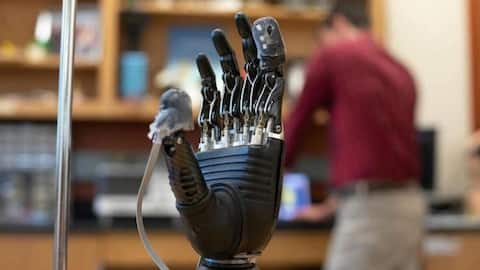Electronic skin 'e-dermis' lets amputees feel through prosthetic limbs
What's the story
Over the last few years, the field of prosthetics has seen unprecedented advances - from perfectly-fitting 3D-printed limbs, to robotic limbs that can be controlled with our minds. Yet, one crucial element was always missing - feeling. Now, researchers from the Johns Hopkins University have created an electronic skin which allows amputees to feel sensations via artificial limbs. The research has other implications too.
How it works
How the electronic skin allows amputees to feel objects
The electronic skin, dubbed e-dermis rather unimaginatively, is inspired by human biology. Made of fabric and rubber, the e-dermis is laced with sensors that mimic nerve endings on human fingertips. The sensory receptors detect how an object feels like - whether it's sharp or round, for example - and relays these via wires to the peripheral nerves in an amputee's residual limb.
Quote
Amputee volunteer recounts what it felt to feel again
"After many years I felt my hand, as if a hollow shell, got filled with life again. I can differentiate between pain and not-pain without thinking, instinctively knowing if my arm is in danger," said the anonymous amputee who served as the researchers' primary volunteer.
Caveats
The e-dermis can't feel temperature, yet
For the study, however, researchers designed the e-dermis to perceive only two sensations - an object's curvature (for touch, shape perception), and sharpness (for pain perception). Despite this limitation, researchers made a fundamental breakthrough - they created a "neuromorphic model" which allows the e-dermis to electronically encode sensations, akin to sensory receptors in human skin. Given this, temperature perception might not be far off.
Usage
The e-dermis can be slipped on to available prosthetic limbs
What perhaps makes the e-dermis (economically) ingenious is the fact that limbs supporting e-dermis don't have to be separately produced. Instead, the e-dermis can be slipped on to a prosthetic hand already available in the market, and therefore, large-scale use of the product, when commercially available, won't require massive changes. Further research on expanding the spectrum of feelings felt by e-dermis is currently underway.
Implications
The e-dermis could be used in robotics, astronauts' suits
The implications of the research i.e. electronically allowing an artificially created membrane to "feel", isn't limited to just prosthetics. The e-dermis, for instance, could later be used to robots, thus enabling them to electronically "feel" sensations which are otherwise human. It could also be used on astronaut gloves and spacesuits, thereby allowing astronauts to feel objects more accurately via their gloves.
Information
For those interested: Here's where you can access the study
The team of researchers from Johns Hopkins published their research on the electronic skin on June 20, in the journal Science Robotics. For those interested, the entire study can be accessed here, provided you have a subscription to the journal.
